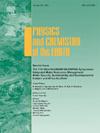Deciphering sediment pathways: Novel integrated approaches for sediment source identification and vulnerability prediction by machine learning models in major dam catchments in Chota Nagpur plateau, India
IF 4.1
3区 地球科学
Q2 GEOSCIENCES, MULTIDISCIPLINARY
引用次数: 0
Abstract
The declining storage capacity of major dam reservoirs in the Chota Nagpur Plateau is primarily attributed to excessive sedimentation from upper catchments. However, identifying sediment source zones and understanding sediment connectivity remains a challenge. This study introduces an integrated ‘RUSLE–IC–SDR-SWAT-SEH-ML’ framework to assess reservoir sedimentation by combining soil erosion hotspots (SEH) with sediment connectivity pathways. The methodology was applied to the Maithon, Panchet, and Tenughat dam catchments to evaluate sediment yield (SY) variations. The results indicate an increasing trend in severe soil erosion (SE) across all catchments, with Maithon exhibiting an increase from 0.74 % to 1.36 % (Δ0.31, R2 = 0.65), Panchet from 1.78 % to 3.58 % (Δ0.285, R2 = 0.52), and Tenughat from 0.92 % to 1.49 % (Δ0.7, R2 = 0.69). The SWAT model estimated mean SY at 9.146 (Tenughat), 5.871 (Panchet), and 7.662 (Maithon). Machine learning analysis showed SVM as the best performer for Maithon and Tenughat, while RF was superior for Panchet (R2 = 0.998, 0.994) in predicting SY vulnerability. The extent of well-connected areas increased from 14.45 km2 to 17.69 sq.km in Maithon, 21.22 sq.km to 26.64 sq.km in Panchet, and 18.77 sq.km to 22.96 sq.km in Tenughat, indicating an intensifying risk of sediment input into the reservoirs. The Mantel test confirmed that key variables explained 90–97 % of SY variance across the catchments (p < 0.001). ANOVA results showed a statistically significant difference (p < 0.001) within the catchments, while the LSD post-hoc test revealed significant differences (p < 0.05) between Maithon and Panchet, as well as Panchet and Tenughat. The observed differences between the Panchet and Tenughat dams (p < 0.001) are attributed to the regulation of water and sediment flow in the Panchet Dam's upper catchment through the Tenughat Dam. Additionally, the Panchet Dam catchment exhibited the highest sediment yield due to extensive mining activities, leading to significant statistical differences compared to Maithon. This study underscores the importance of integrating sediment connectivity analysis and machine learning models for effective reservoir sediment management. The findings provide critical insights for sustainable soil and water conservation strategies in sediment-prone dam catchments.

解析泥沙路径:基于机器学习模型的印度乔塔那格浦尔高原主要水坝集水区泥沙来源识别和脆弱性预测的新综合方法
高塔那格浦尔高原主要水库蓄水能力下降的主要原因是上游集水区的过度沉积。然而,确定沉积物源区和了解沉积物连通性仍然是一个挑战。本研究引入了一个集成的“RUSLE-IC-SDR-SWAT-SEH-ML”框架,通过结合土壤侵蚀热点(SEH)和沉积物连接路径来评估水库沉积。该方法应用于maathon, Panchet和Tenughat水坝集水区,以评估泥沙产量(SY)变化。结果表明,各流域的严重土壤侵蚀呈增加趋势,其中马赛从0.74%增加到1.36% (Δ0.31, R2 = 0.65),潘切特从1.78%增加到3.58% (Δ0.285, R2 = 0.52),特纳赫特从0.92%增加到1.49% (Δ0.7, R2 = 0.69)。SWAT模型估计平均SY为9.146 (Tenughat), 5.871 (Panchet), 7.662 (mathon)。机器学习分析显示,SVM对Maithon和Tenughat的预测效果最好,而RF对Panchet的预测效果更优(R2 = 0.998, 0.994)。连通面积从14.45平方公里增加到17.69平方公里。马拉松的面积为21.22平方公里。公里至26.64平方公里。潘切特的土地面积为18.77平方公里。公里至22.96平方公里。表明沉积物进入水库的风险正在加剧。Mantel测试证实,关键变量解释了流域间90 - 97%的SY方差(p <;0.001)。方差分析结果显示差异有统计学意义(p <;0.001),而LSD事后检验显示显著差异(p <;0.05),以及潘切特和特努哈特之间的差异。Panchet和Tenughat大坝的观测差异(p <;0.001)归因于Panchet大坝上部集水区通过Tenughat大坝对水和泥沙流动的调节。此外,由于广泛的采矿活动,Panchet水坝集水区的产沙量最高,与mathon相比具有显著的统计差异。这项研究强调了将沉积物连通性分析和机器学习模型结合起来对有效的水库沉积物管理的重要性。这些发现为易淤积的水坝集水区的可持续水土保持策略提供了重要的见解。
本文章由计算机程序翻译,如有差异,请以英文原文为准。
求助全文
约1分钟内获得全文
求助全文
来源期刊

Physics and Chemistry of the Earth
地学-地球科学综合
CiteScore
5.40
自引率
2.70%
发文量
176
审稿时长
31.6 weeks
期刊介绍:
Physics and Chemistry of the Earth is an international interdisciplinary journal for the rapid publication of collections of refereed communications in separate thematic issues, either stemming from scientific meetings, or, especially compiled for the occasion. There is no restriction on the length of articles published in the journal. Physics and Chemistry of the Earth incorporates the separate Parts A, B and C which existed until the end of 2001.
Please note: the Editors are unable to consider submissions that are not invited or linked to a thematic issue. Please do not submit unsolicited papers.
The journal covers the following subject areas:
-Solid Earth and Geodesy:
(geology, geochemistry, tectonophysics, seismology, volcanology, palaeomagnetism and rock magnetism, electromagnetism and potential fields, marine and environmental geosciences as well as geodesy).
-Hydrology, Oceans and Atmosphere:
(hydrology and water resources research, engineering and management, oceanography and oceanic chemistry, shelf, sea, lake and river sciences, meteorology and atmospheric sciences incl. chemistry as well as climatology and glaciology).
-Solar-Terrestrial and Planetary Science:
(solar, heliospheric and solar-planetary sciences, geology, geophysics and atmospheric sciences of planets, satellites and small bodies as well as cosmochemistry and exobiology).
 求助内容:
求助内容: 应助结果提醒方式:
应助结果提醒方式:


